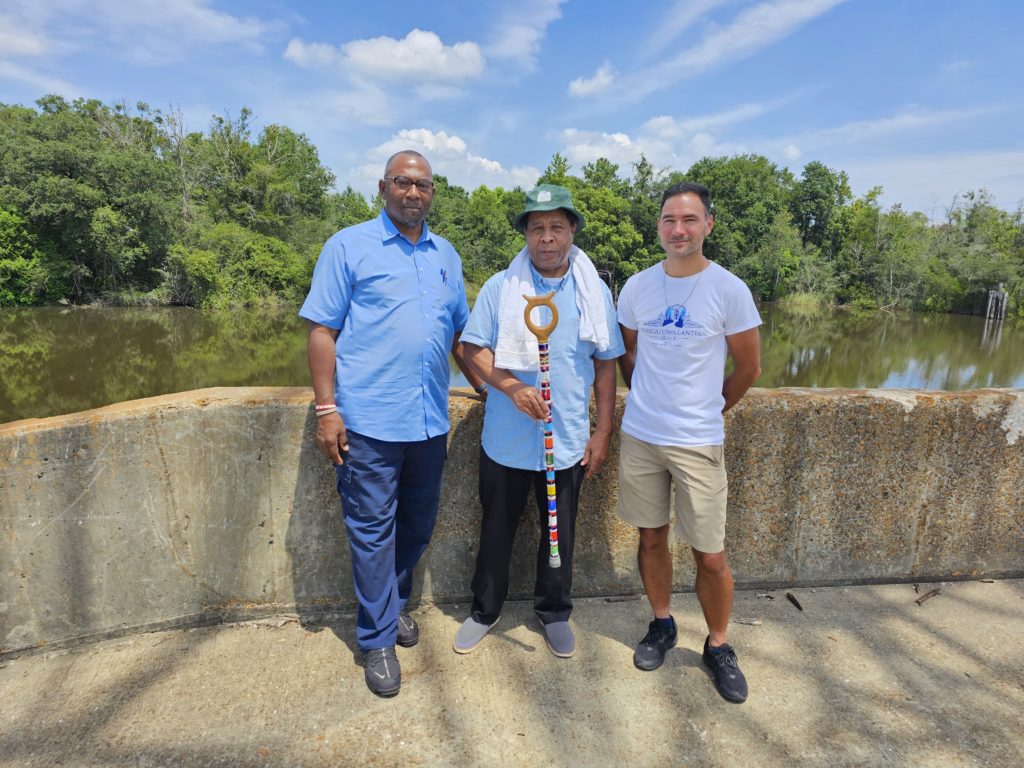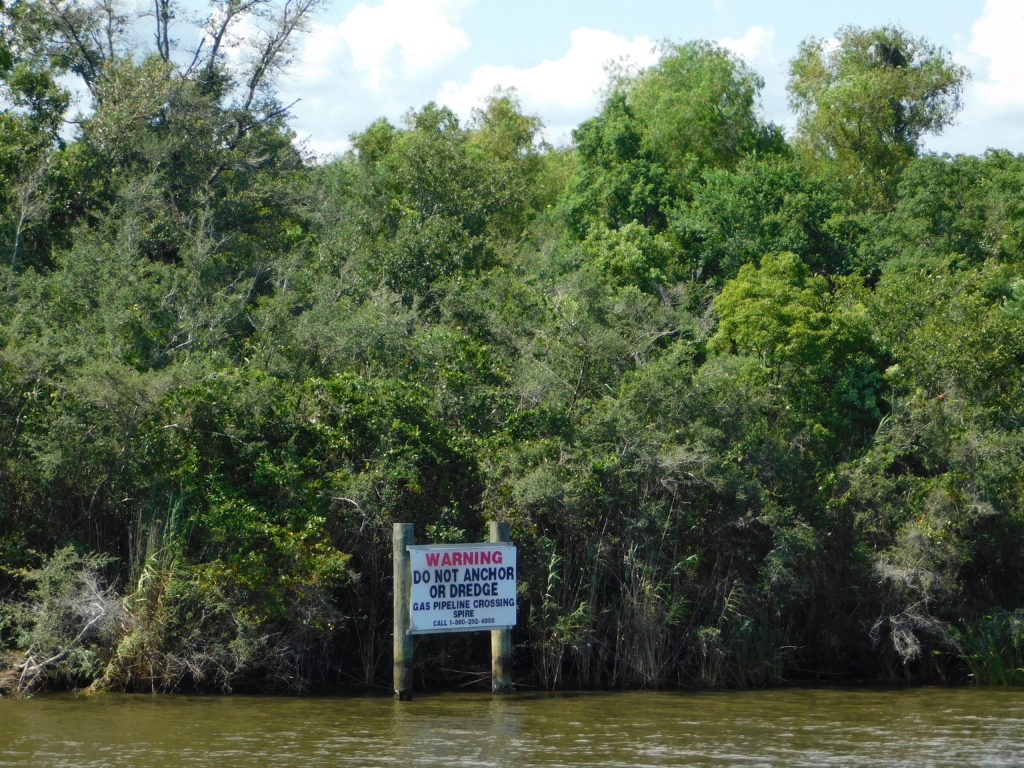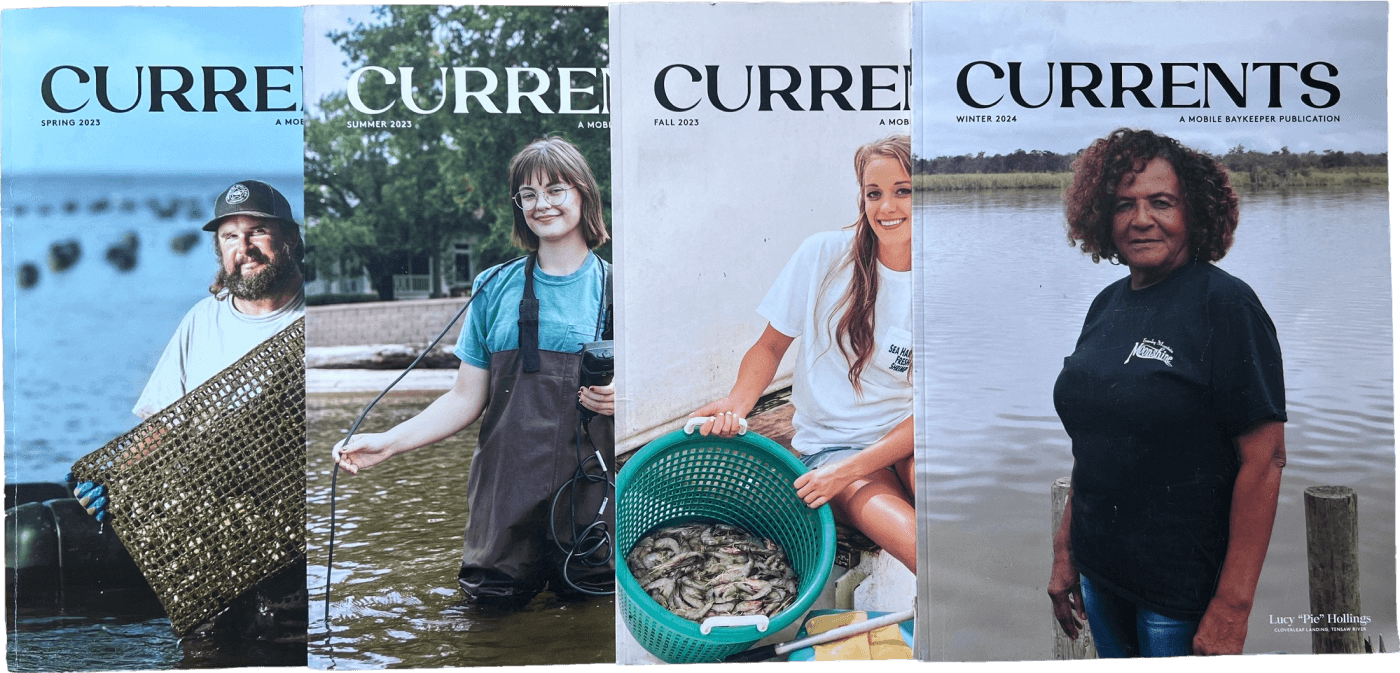
This article is from the fall edition of Mobile Baykeeper’s print quarterly, CURRENTS. The magazine is mailed to active members who have given more than $50 in 2023. To get on the magazine’s mailing list, donate here.
by Emmie Fontenot
Once a sportsman’s paradise, this sliver of Africatown has been despoiled by pollution and closed off from the public via land-access.
Six miles north of Downtown Mobile, in the heart of Africatown, sits a formerly beloved body of water known as Hog Bayou. Back in the day, the area surrounding the bayou was referred to as the “Happy Hunting Grounds” by the locals for its abundant wildlife and lush vegetation. For more than 50 years, industry has encroached upon Hog Bayou, and Africatown as a whole, leaving much damage in its wake. Today the safety status of the area for recreation remains questionable.
I spent an afternoon in Africatown looking for waterfront access to Hog Bayou by foot. The only glimpse of water I saw was near the Mobile Energy factory. All access points are barricaded by train tracks, factories, fences, gates, and signs that say “no trespassing.”
Recently, I spoke about Hog Bayou with Joe Womack, an Africatown native who plays a significant role in the community with the C.H.E.S.S. organization. We discussed the Bayou’s current state and what the future holds for Africatown. We also spoke with Ramsey Sprague, who heads the Mobile Environmental Justice Action Coalition (MEJAC) and has called the area home for more than a decade.
Like many historically Black communities across the U.S., Africatown has been a victim of environmental injustice. As a coastal community, we continue to face a raft of environmental threats, both natural and manmade. We cannot face them alone. We must stand together for a resilient future for Coastal Alabama.
Past and Present
Hog Bayou was once a lush, natural pantry. Womack said during Mobile’s antebellum period, they called it the “Happy Hunting Grounds.” He said after slavery ended, the community did not de- velop Hog Bayou because it highly valued the food the land provided for the community.
Even when Womack was a child, Hog Bayou was still an important hunting ground. He says some of his fondest childhood memories involve swimming and playing in the water. He especially enjoyed fishing and hunting with his grandfather and his brother at his grandfather’s small hunting club there.
Although the people of Africatown did not want to develop Hog Bayou, some industrial companies had different plans. Scott Paper International built its plant at the mouth of Hog Bayou, which blocked public access. The entrance to Hog Bayou now sits behind a “no trespassing” sign encircled by the Mobile Energy plant and the Borusan Berg pipeline. Prior to industrial development, the community could just walk across the street to the water.
Over the last 50 years, industry has moved into the area and exploited Africatown. Chemical plants and other factories arrived as a result of negligent zoning regulations, faulty permits, and the promise of progress. Consequently, these factories have polluted the community since the 1960s, with Hog Bayou being a main target for industrial development due to its position on the water.
Access to the water in Africatown was crucial back in the day and remains a top priority for many today. The area of Hog Bayou was important, not only for community food supply, but also for recreation. Womack remembers swimming in the water near Hog Bayou, even after Scott Paper International had moved in.
“We would always find a way to get back to the water,” he said. “Kids today don’t even know it’s back there.”
I spoke with several residents, and only two of the seven people I met knew of Hog Bayou, and they were over the age of 50. But Womack and other leaders in Africatown are looking to change that.

The Future
Womack wants to turn Hog Bayou into a national park. “We want a place where the kids can learn about the water and the nature that’s right there and within walking distance, so they can enjoy it like we did.”
Currently, the community is working with the EPA for safety testing and clean-up work. Although the state has known of the pollution-caused issues, it has yet to act on mitigating the harmful effects. Scott Paper International is no longer operating in the community, though much of the area is now occupied by Borusan Berg Pipe.
“The state really hasn’t done its due diligence in terms of trying to classify Hog Bayou itself,” said Ramsey Sprague. “The fact that it is so understudied is really glaring. Today, it is still unknown whether it is safe to be on or swim around Hog Bayou.”
Womack, Sprague, and others are currently working hard to combat the environmental injustices that have been imposed upon the Africatown community. Sprague believes that MEJAC has made significant progress over the last decade. Yet there are still quality-of-life issues in Africatown that deserve immediate attention.
Womack is hopeful for the future of Hog Bayou and the Africatown community.
“We want to be a living monument to the last shipment of slaves,” Womack said. “They had a dream that, once they were freed, to turn that area where they lived into their own Africa. So, we feel as though we have to pick up the torch, and you know we don’t know what their Africa was, but we can imagine what they envisioned it to be.”
Africatown has much to offer historically and culturally, but also recreationally. Sprague’s favorite memory of the Mobile Bay Watershed involves kayaking the Africatown Connections Blueway along Chickasaw Creek. “There is no other waterway like that around with the speed and the turns,” Sprague said. “There is nothing in Baldwin County that comes close. It’s a special waterway. I really want more people to experience it.”
In early July, the Africatown Heritage House Museum had its grand opening. Notable guests included staff from the National Smithsonian African American History Museum. Several national news outlets covered the event, including CNN, 60 Minutes, and The Washington Post.

Environmental Injustice
Africatown is just one example of a minority community that faces environmental injustices in our state and nation. Environmental in- justices occur when a community is unwillingly forced to endure an unsafe environment due to various types of pollution and, in turn, experiences health issues and a reduced quality of life. Some significant areas of environmental injustice include Uniontown, Alabama; Flint, Michigan; and the area of Louisiana known as “Cancer Alley.”
The EPA defines environmental justice as “the fair treatment and meaningful involvement of all people regardless of race, color, national origin, or income, with respect to the development, implementation, and enforcement of environmental laws, regulations, and policies.”
I asked Womack and Sprague what they believe is the best path to remedy the environmental injustices in the state of Alabama. Sprague highlighted the need for education, correct information, and access to political power for marginalized communities.
“I think the history has to be told correctly,” Sprague said. “The Black population in Mobile County in particular is underserved by not having proper political representation.”
Womack emphasized the need for a more binding, legal framework. “We have to put real teeth into laws that are affecting the people who make those decisions that are hurting people,” he said. “If you’re in the Wild, Wild West, and you’ve got a sheriff, and every time someone gets shot, and he turns the other way, he is not doing his job.”
Water Unites
As a coastal community, we greatly value living on the water. But living on the water can also bring uncertainty and distress, especially in a rapidly changing natural world. We must foster community and make genuine connections to face these problems together. Womack wants the people of Mobile to remember that we are fortunate to be on the Gulf Coast, and Sprague wants to make it clear that “environmental justice is for everybody.”
Together we can be resilient. The future of Hog Bayou could serve as a prime example of how healing the waterways can, in turn, heal the community for future generations.
Emmie Fontenot, a student at the American University of Rome, worked this summer as a communications intern at Mobile Baykeeper.
Top photo: The “Happy Hunting Grounds” near Hog Bayou. Photo by Emmie Fontenot
